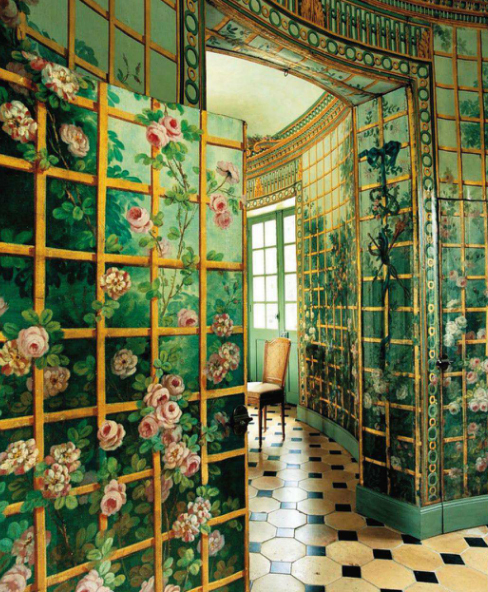Verre Eglomise
Fontana Arte c.1960 coffee table at Bernd Goeckler’s booth at the Salon Art +Design
If you are going to walk the walk, you should talk the talk.
What is verre eglomise?
VERRE EGLOMISE: Glass which has been painted on the reverse to depict a picture or other design that shows through to the other side. The glass is often (but not always) gilded in gold or metal leaf. Sometimes shortened to “eglomise.”
The practice dates back to the pre-Roman days, but the name comes from an eighteenth century French decorator and art dealer Jean-Baptise Glomy who is credited for reviving the process.
It also was very popular during the Federal period, frequently used then to decorate case pieces. Joseph Barry, a Baltimore maker, is known for mastering the technique.
Federal period secretary
Examples
I spotted several examples of the beautiful practice of verre eglomise when I made the design rounds this fall, like the gorgeous coffee table by Fontana Arte shown above at Bernd Goeckler’s booth at the Salon Art+Design.
Bernd Goeckler displayed more at the International Fine Art and Antique Dealers Show. You can catch a glimpse of the monumental 25 panels of verre eglomise created by Paule Ingrand, in France c. 1942 behind the chandelier in their always chic booth. The panels depict the myth of Diane the Huntress. I shot some details–tricky because of the reflection–but I hope you get the idea.
Bernd Goeckler always has a chic booth at every show. Here you see “Diane the Huntress” by Paule Ingrand c.1942 behind the chandelier at the International Fine Art and Antique Dealers show
“Diane the Huntress” by Paule Ingrand c.1942
Detail from “Diane the Huntress” by Paul Ingrand, France, 1942
Detail from Diane the Huntress”” by Paule Ingrand
Show House Favorite
The technique is a show house favorite. Over at Holiday House NYC, designer Patrik Lonn used verre eglomise in a more contemporary way with an installation in the back of a bookcase.
Who can forget the memorable ceiling by in room in the 2011 Kips Bay Showhouse.
Who can forget the memorable ceiling by Miriam Ellner in Celerie Kemble’s room in the 2011 Kips Bay Showhouse.
Celerie Kemble’s room in the 2011 Kips Bay Show House with its verre eglomise ceiling.
Designer Darren Henault also used reverse painted glass in his Kips Bay room, this time on the closet doors.
More Inspiration
Verre eglomise on the powder room walls
Via World of Interiors. Verre Eglomise walls.
Verre eglomise panel from Sterling Studios
I have a small bit of verre eglomise in my own home. It’s a pretty landscape on a late federal mirror.
Photo Credits: First image, my own. Diana the Huntress from Bernd Goeckler. Booth and Details, ,my own. Fontana Arte coffee table and detail from Bernd Goeckler. Holiday House photos my own. Celerie Kemble collage: room from Elle Decor, ceiling photograph by Marco Ricca, chandelier photograph by Nick Johnson, sofa shot by Heather Clawson. Darren Henault image from his website. Federal secretary Powder room. World of Interiors, Sterling Studio














